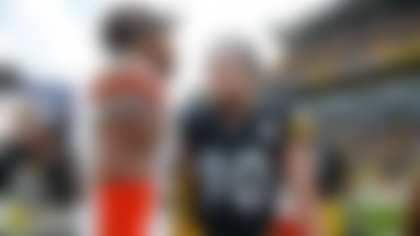I hear analysts on television refer to the Wildcat formation as a gimmick. Webster's dictionary defines a gimmick as "a trick." By that definition, the Wildcat is not a gimmick; coaches I spoke to about it haven't been tricked by it, but the formation does concern them.
Some observers call the Wildcat a trend, but Webster's defines a trend as "veering in a new direction." Former NFL quarterback Billy Kilmer recently told Hall of Fame quarterback Dan Marino that he ran it in the 1950s. So it's not really a trend, either.
So what is the Wildcat then? NFL coaches talk about it in terms of a package. Webster's defines a package as "a group or bundle."
So from now on, I will be looking at the Wildcat "package." For this study, I was curious how one former NFL head coach would construct his Wildcat package and how another former NFL head coach would defend it.
From everyone I talked with and from video I watched, no team is committed to the Wildcat as the mainstay of its offense. Consequently, defenses have developed a "check" system to play the Wildcat if it shows up in a game. If it is 10 percent of a team's offense, then an opposing defense can only spend 10 percent of its prep time on it. But any good defense has already worked on it at least a little, so it should not take anyone by surprise.
The NFL version of this package is to come out of the huddle with the quarterback lined up as a wide receiver and the running back, or a wide receiver, in shotgun formation behind the center. From that basic principle, a "package" of plays can be developed based on the talents of the player taking the snap.
First, a few concepts that former Steelers coach Bill Cowher sees when it comes to defending the Wildcat:
» There is a "mesh point" where the shotgun player will engage another runner with the ball somewhere in the backfield. This point has to be defended.
» A defensive player has to be assigned to the ball.
» The whole package has to be contained and can never get on the perimeter.
» Of all the plays in the package, the pass is the defense's least concern.
Below is a step-by-step defensive package that Cowher would build to defend the Wildcat. Because the quarterback is in the huddle with a number of personnel groupings, there is no way to tell when the Wildcat will be utilized. So Cowher built his "check" package with the idea that if an opposing offense came out of the huddle and was set up in a Wildcat, his team would check out of the defense called and go to a Wildcat defense. The middle linebacker would yell "check cat," and the following would transpire:
Disrupt the mesh point
The nose tackle and the two inside linebackers would go to a blitz look to disrupt the "mesh point," when the shotgun back and another back would engage in a handoff or a fake handoff.
Cowher knows that there is a timing issue between the two players and he wants to destroy the mesh.
Key the ball
Because the running back can go anywhere after the middle linebacker calls "check cat," the strong safety lines up in the middle of the field about 9 yards off the line and "keys" the ball. He goes where the ball goes.
If the shotgun back keeps it, he meets him at the line of scrimmage; if he hands off, then the strong safety follows the handoff back; if he rolls out to throw, then the strong safety scrapes and blitzes the thrower after he breaks containment. A player like Troy Polamalu would be in on a lot of tackles against this package. He's the perfect "key" player.
Contain the edges
Cowher does not want any of the Wildcat plays to get outside, so he will contain rush his defensive ends. Their job is to turn the ball back inside. They will work for width as they get upfield.
Cheat coverage on QB
As for the secondary and pass coverage, it will be more of a three-under, three-deep scheme. Keep in mind, the defense is not as concerned about the pass because the shotgun player is not a passer by trade.
The cornerback aligned to the quarterback (who is lined up wide) will cheat inside of the QB and off the ball at 6 yards. He is a deep third player but is coached to look to support the rest of the package as well as cover the QB. If the QB were to head into the backfield at the snap of the ball in order to receive a handoff and become a passer, then the corner could follow him into the backfield on a corner-blitz look and disrupt the mesh point.
There will always be a deep middle safety to cover any breakdowns up front and prevent a deep pass. The two outside linebackers and the strong safety form the three-underneath coverage.
The offensive perspective
On my training camp tour this summer, I saw a large number of teams practicing their version of the Wildcat package. Some have been using it in the regular season, while others have left it on the backburner. Below are the four most important plays in the package as it's been used thus far.
Note: One thing you will rarely see any of these teams do is run the ball to the side of the field where the QB is lined up, because it puts him at risk if he is trying to block a linebacker.
Speed sweep keeper
Miami first came out in this look with Ronnie Brown in the shotgun and Ricky Williams in the slot. Williams went in short motion before the snap to Brown and there was a mesh point between the two backs after Brown received the snap. Cowher's principle of disrupting the mesh with an inside blitz could have disrupted the play at that point.
The "key" defender had to hold his ground until he determined whether Brown kept the ball and went outside to his left or handed it to Williams running right. The contain ends had work to do to make sure whoever had the ball was turned back inside to the "key" player. If they failed, the outside linebackers would support the run. Keep in mind the corner to the quarterback side is lined up inside the QB and can support the run late without being blocked.
Power play
The Dolphins used this power play last week. Note that left tackle Jake Long pulled and led the power run off-tackle. Also note that there was a mesh point between the shotgun back, Brown, and Williams, who took the fake and replaced Long as he pulled. There was also a fullback in the backfield to lead up with Long.
One of the blitzing inside linebackers would engage either Long or the fullback. The outside linebacker would meet the other lead blocker and the plan would be for the "key" defender to meet the ball carrier in the hole. Remember, Cowher has a deep middle safety to clean it up if need be.
Lead weak
The Kansas City Chiefs, among other teams, will run a lead play weak. There is no mesh point between two players in the backfield and the play develops quickly, so the inside blitz could work against the defense. The fullback will find the outside linebacker and kick him out.
The offensive tackle will turn the defensive end out -- which is easy, because the DE is thinking contain anyway. But there would not be a blocker for the "key" defender, who would meet the ball carrier in the hole.
Pass play
The pass is a possibility, and a good scouting report will remind everyone of the quality of the arm of the player in the shotgun. The Dolphins' Brown has already thrown a touchdown. Oakland's Darren McFadden was a high school QB, as was Anquan Boldin of Arizona. Washington's Antwaan Randle El was a college QB. So an alert is in order.
Cowher is more worried about the wide receiver side than the quarterback side of the Wildcat when it comes to the pass. The corner to the wide receiver side has been playing a soft cover-3 look and thinking pass since the "check cat" call was made. The outside linebackers and the key player will adjust as the shotgun player gets width and the "key" player will pressure the ball.
The Wildcat is a fundamentally sound package and has its place in the pro game. It can be an effective package against teams without a good check package. It can also help an offense survive a injury to its quarterback.
No one should call it a gimmick. A double-reverse pass with the intention to fool a team is a gimmick, and the defense can't spend much time preparing for that. The Wildcat package can cause problems in a number of ways, and the defense knows it's coming at them.
And it just might be here to stay.



